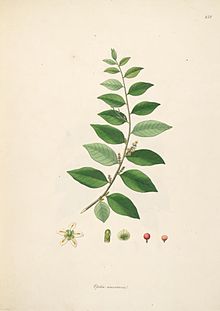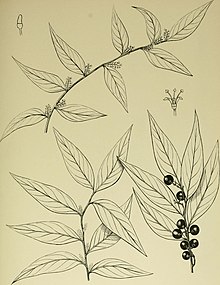Opiliaceae
| Opiliaceae | ||||||||||||
|---|---|---|---|---|---|---|---|---|---|---|---|---|

Urobotrya angustifolia , illustration |
||||||||||||
| Systematics | ||||||||||||
|
||||||||||||
| Scientific name | ||||||||||||
| Opiliaceae | ||||||||||||
| Valeton |
The Opiliaceae are a plant family in the order of the sandalwood-like (Santalales) within the flowering plants (Magnoliopsida). The approximately twelve types are common in the tropics of the New (only one type) and Old World (eleven types).
description


Vegetative characteristics
The species of Opiliaceae are evergreen, woody plants that grow as trees , shrubs, or lianas . All kinds of the Opiliaceae root parasites .
The alternate leaves , usually arranged in two rows, are mostly petiolate. No leaf veins can be seen on large areas of the simple, entire leaf blades . Stipules are missing.
Generative characteristics
They are dioecious separately sexed ( dioecious ) or some species have hermaphroditic flowers. The inflorescences are grapes , ears or panicles and sometimes cauliflor . In many species, the young inflorescences look like catkins.
The small hermaphrodite or unisexual flowers are usually four to five-fold. The single or double inflorescence , if present, usually consists of four to five sepals and / or petals , or there are three to eight bracts of the same shape. In the male flowers there are four to five stamens and usually a pistillode. In the female flowers are two to five carpels to a mostly upper constant ovary grown and Staminodien may occur. The hermaphrodite flowers contain stamens and an ovary. There may be a discus .
There are drupes formed with a large oil-containing seeds.
Systematics
Taxonomy
The Opiliaceae family was established in 1886 by Theodoric Valeton in Critisch Overzicht der Olacineae , 136. The type genus is Opilia Roxb.
External system
The Opiliaceae family belongs to the Santalales order . AGP II, III and IV put the order Santalales to the nuclear eudicotyledons .

Internal systematics, genres and their distribution
Le et al. divide the family Opiliaceae in 2018 into three tribes with a total of twelve genera and about 36 species:
- Tribus Agonandreae Engl .: It contains two genera:
- Agonandra Miers ex Benth. & Hook. f. : The tenor sospecies are distributed from Mexico through Central America to tropical South America , including:
-
Gjellerupia Lauterb. (The position in this tribe is not secured.): There is only one kind:
- Gjellerupia papuana Lauterb. : It occurs in western and northern New Guinea.
- Tribe Anthoboleae Bartl. ex Spach : It contains only one genre:
- Anthobolus R.Br. : The three or so species occur in central to northern Australia .
- Tribus Champereieae Bing Liu, CTLe, LMLu & ZDChen : It was set up in 2018 and contains three monotypical genera, i.e. only three species:
-
Champereia Griffith : There is only one type:
- Champereia manillana (flower) Merr. : Contrary to the previous assessment, according to Le et al. 2018 only in Southeast Asia and not in other areas as well.
-
Melientha Pierre : There is only one type:
- Melientha suavis Pierre : The two subspecies occur in northern Southeast Asia .
-
Yunnanopilia C.Y.Wu & DZLi : There is only one type:
- Yunnanopilia longistaminea (WZLi) CYWu & DZLi : It occurs in the southwestern Chinese provinces of Yunnan and Guangxi.
-
Champereia Griffith : There is only one type:
- Tribe Opilieae Benth. : It contains two types:
- Cansjera Juss. : The threeor sospecies are distributed from Sri Lanka via India to southern China , New Guinea and northern Australia.
-
Lepionurus flower : there is only one species:
- Lepionurus sylvestris flower : It occurs from Nepal and Assam to western Malesia and Yunnan .
- Opilia Roxb. : The only two species are both found in tropical Africa and one is also common in tropical Asia, the Solomon Islands and northern Australia.
- Pentarhopalopilia (Engl.) Hiepko : The four or so species are common in tropical Africa and Madagascar .
- Rhopalopilia Pierre : The three or so species are common in tropical Central Africa.
- Urobotrya Stapf : Of the seven or so species, two are distributed from West to Central Africa and five in tropical Asia.
swell
- The family of Opilaceae in APWebsite . (Sections Description and Systematics)
- The Opiliaceae family at DELTA by L. Watson & MJ Dallwitz. (Section description)
- Entry in the Western Australian flora . (engl.)
literature
- Huaxing Qiu, Paul Hiepko: In: Wu Zhengyi, Peter H. Raven, Deyuan Hong (Eds.): Flora of China , Volume 5: Ulmaceae through Basellaceae. Science Press and Missouri Botanical Garden Press, Beijing and St. Louis, 2003, ISBN 1-930723-27-X . Opiliaceae , pp. 205–206 - online with the same text as the printed work.
- Daniel L. Nickrent et al .: A revised classification of Santalales. In: Taxon , Volume 59, 2010, pp. 538-558.
- Chi Toan Le, Bing Liu, Russell Barrett, Limin Lu, Jun Wen, Zhiduan Chen: Phylogeny and a new tribal classification of Opiliaceae (Santalales) based on molecular and morphological evidence: Phylogeny and classification of Opiliaceae. In: Journal of Systematics and Evolution , Volume 56, January 2018, pp. 56-66. doi : 10.1111 / jse.12295
- Paul Hiepko : The genus delimitation with the Opiliaceae. In: Reports of the German Botanical Society , Volume 84 ("1971"), pp. 661-663, 1972.
- Paul Hiepko: A revision of Opiliaceae I. Genera of the eastern Old World, excluding Opilia. In: Willdenowia. Volume 9, 1979, pp. 13-56.
- Paul Hiepko: A revision of Opiliaceae II. Opilia Roxb. In: Willdenowia , Volume 12, 1982, pp. 161-182.
- Paul Hiepko: A revision of Opiliaceae III. Urobotrya Stapf. In: Botanical yearbooks for systematics, plant history and plant geography. Leipzig , Volume 107, 1985, pp. 137-152.
- Paul Hiepko: A revision of Opiliaceae IV. Rhopalopilia Pierre and Pentarhopalopilia (Engler) Hiepko gen. Nov. In: Botanical yearbooks for systematics, plant history and plant geography. Leipzig , Volume 10, 1987, pp. 271-291.
Individual evidence
- ↑ a b c d e f g h i j k l m n o p q r s t u v Chi Toan Le, Bing Liu, Russell Barrett, Limin Lu, Jun Wen, Zhiduan Chen: Phylogeny and a new tribal classification of Opiliaceae (Santalales) based on molecular and morphological evidence: Phylogeny and classification of Opiliaceae. In: Journal of Systematics and Evolution , Volume 56, January 2018, pp. 56-66. doi : 10.1111 / jse.12295
- ↑ a b Opiliaceae at Tropicos.org. Missouri Botanical Garden, St. Louis, accessed May 7, 2020.
- ↑ a b The family of Opilaceae in APWebsite .
- ^ A b c d Rafaël Govaerts: World Checklist of Seed Plants 1 (1, 2), 1995, pp. 1-483, 1-529. MIM, Deurne, Rafaël Govaerts (Ed.): Opiliaceae. In: World Checklist of Selected Plant Families (WCSP) - The Board of Trustees of the Royal Botanic Gardens, Kew . Retrieved May 6, 2020.
Web links
- Opiliaceae in Parasitic Plants .
- Entry in the Flora of Zimbabwe . (engl.)
- Opiliaceae on the Germplasm Resources Information Network (GRIN), USDA , ARS , National Genetic Resources Program. National Germplasm Resources Laboratory, Beltsville, Maryland.


